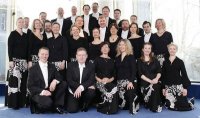
Swedish Radio Choir Awe-Inspiring in Cincinnati Debut
A singer’s voice is often referred to as an “instrument.” Like a violin or a flute, the singer’s vocal
chords are what he or she plays.

The Swedish Radio Choir is made up of 32
instruments and their owners play them with the color and flexibility of a
chamber orchestra.
The Swedish choristers led by guest
conductor Ragnar Bohlin made this clear from the very first notes heard on
their concert at St. Peter in Chains Cathedral Wednesday evening. The gentle interval sung by the women,
underlined by the dark tones of the men at the start of Hugo Alfven’s “Aftonen”
(“Evening”) created a startling impression.
You could hear – and “see” with your ear – “shepherd’s horns sing(ing) lullabies”
as the sun sank beneath the horizon.
Also on the
concert, which drew visitors from the American Choral Directors Association conference
taking place in Cincinnati Feb. 24-27, were a capella works by Sven David
Sandström,
Ned Rorem, Gustav Mahler and Frank Martin.
Nurtured by
the legendary Eric Ericson, the Swedish Radio Choir is one of the finest a
capella choirs in the world (the writer first heard them at the Baltic Sea
Festival in Stockholm in 2006 and has never forgotten it). It was
their Cincinnati debut and an event of the first magnitude for St. Peter in
Chains’ “Great Music in a Great Space” series.
They brought
a diverse program of Swedish, German and American choral music in addition to
Swiss composer Frank Martin’s Mass for Double Chorus, considered one of the
greatest choral works of the 20th century. Bohlin, who studied with Ericson in Sweden and
is now chorus director of the San Francisco Symphony, was a vibrant leader,
precise and keenly expressive.
Ned Rorem’s 1973 “In Time of Pestilence,” sung
on the first half, was just one of the highlights of the program. A setting of verses by Elizabethan poet
Thomas Nashe, it comprises six stanzas, each given distinctive musical
treatment. Nashe’s words (from 1593) are
sobering, since bubonic plague was rife in England at the time. Rorem captures this in his music, each stanza
ending with a poignant “I am sick, I must die – Lord have mercy on us.”
Cries of
pain rose up in the first stanza, “Adieu, farewell earth’s bliss,” the women’s
voices sounding sharp, angular lines over a constant pitch held by the men. This was given the opposite treatment in the
last stanza, where the men sounded a keening lament over a long-held note by
the women. The voices came together in a
kind of resignation at the end. In
between were cautionary verses about trusting (not) in wealth, beauty, strength
or wit, the latter set to light, trippingly ironic music. The work as a whole was a tour de force of
vocalism by the choir.
Speaking of
tours de force, the most striking number on the program was Swedish composer
Anders Hillborg’s 1983 “Mouyayoum” for 16-part mixed choir. Wordless, it consists of vowel sounds woven
into a continuous rhythmic stream. Heard
blindfolded, one might have mistaken it for an electronic mix, so clearly were
the voices pitted against each other (there was some whistling, too). The program notes called it “a cosmic trance”
and the effect was truly “out of this world.”
Mahler’s “Ich
bin der Welt abhanden gekommen” (“I am lost to the world”), one of his Rückert songs, was exquisitely done. The sheer quality of the singers’ voices was
continually startling (there were some arresting high notes by one of the
sopranos at one point). Dynamic control
was faultless.
The first
half ended with Swedish composer Sven David Sandström’s “Lobet den Herrn” and
Johann Sebastian Bach’s “Singet dem Herrn ein neues Lied.” This was a deliberate juxtaposition and a
happy one, since Sandström has re-set a number of works by Bach in his own 20th-century
style. His jazzy, 2003 “Lobet den Herrn”
(“Praise the Lord”) for double chorus uses the same text as Bach’s motet of the
same name (BWV 230).
There was a flurry of competing “lobets” at the beginning, with the same on “preiset,” the rhythms bouncing all over each other to come to rest on “alle Völker.”
“Denn seine
Gnade” (“for His grace . . .”) was reflective by contrast, taking its time to
reach “Ewigkeit” (“eternity”). The Bachian
“Alleluia” was gentle and soft, ending with an almost whimsical cutoff.
The
Cathedral’s generous (reverberant) acoustics played some havoc with Bach’s
motet “Singet dem Herrn” (“Sing to the Lord a new song”). It is
a contrapuntal masterpiece, full of technical demands (apparently Mozart was
inspired by it to use fugues in some of his music), but the choir made a
glorious sound and Bohlin terraced the dynamics skillfully.
Martin’s
Mass for Double Chorus made a handsome conclusion to the concert. The work has
been called sober and austere, but as sung by the Swedish Radio Choir in this Cathedral, that
was not necessarily the impression conveyed. The choir’s sound was so full and
rich it might have been heard in Kentucky, and there was a wealth of color and
expressive detail. The Kyrie was genuinely
plaintive. The women’s voices bubbled up
softly on “et resurrexit” In the “Credo,” which was capped by a big,
affirmative “Amen.” “Sanctus” brimmed
with “hosannas,” and the concluding “Agnus Dei” was earnest, pleading and
ultimately serene.